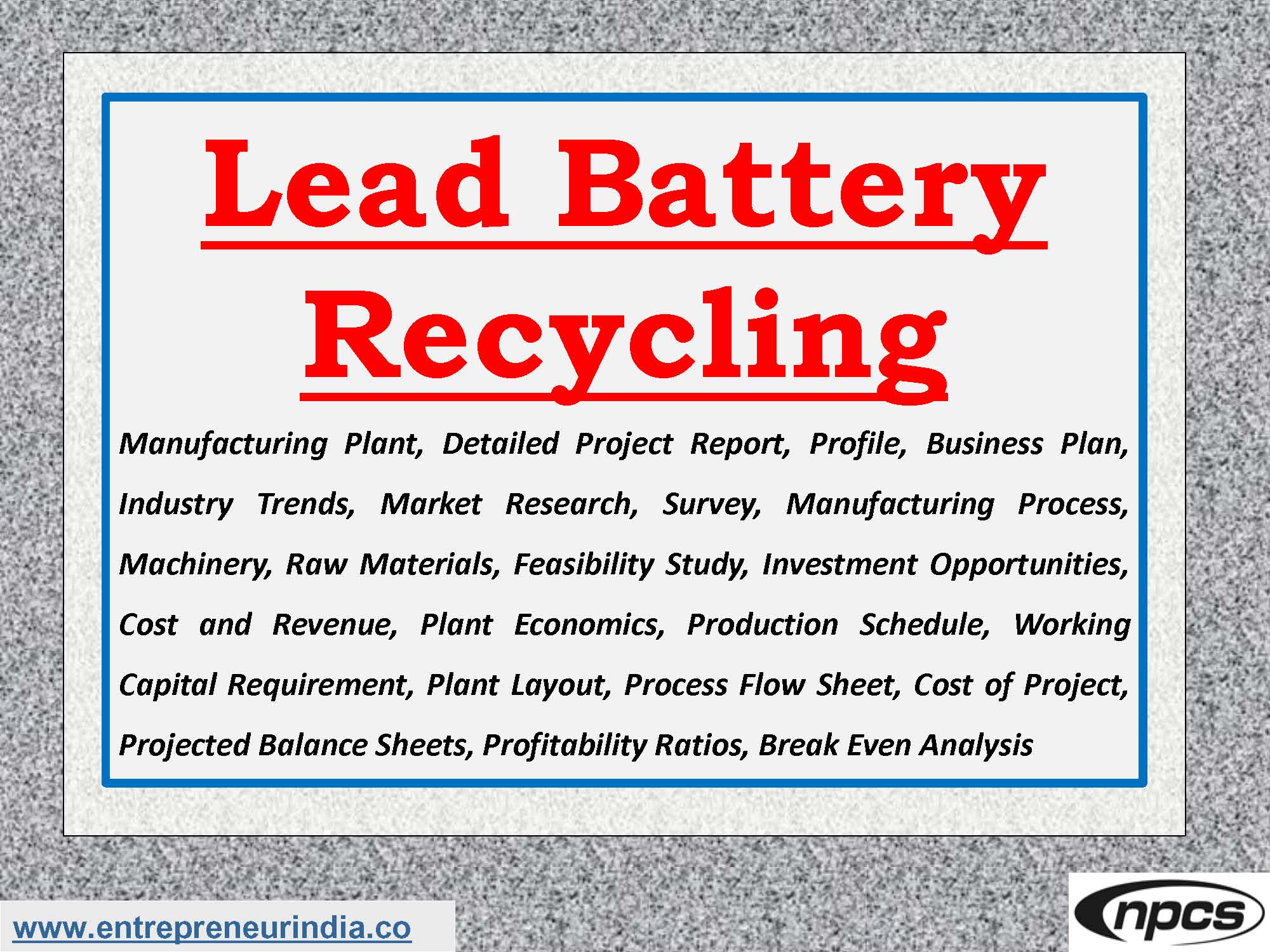
Lead-acid batteries are widely used in automobiles, inverters, UPS systems, and renewable energy storage. However, with increased usage comes the growing challenge of hazardous waste. This has opened the door to a profitable and environmentally crucial business—setting up a Lead Battery Recycling Plant. Recycling not only helps recover valuable lead and plastic but also reduces pollution, supports circular economy goals, and fulfills environmental compliance norms. Moreover, the demand for recycled lead is consistently high in industries like battery manufacturing, construction, and alloys.
Lead Battery Recycling Plant | Setup & Project Report
Establishing a Lead Battery Recycling Plant is a profitable industrial venture that requires technical planning, regulatory approvals, and a focus on environmental safety. Lead is a hazardous heavy metal, and its recycling must be done responsibly to meet CPCB (Central Pollution Control Board) and MoEFCC norms in India. Moreover, this business model benefits from both government support and industry demand, making it a smart investment for entrepreneurs with long-term vision.
Read Also :Profitable Manufacturing & Processing Ideas in Himachal
What Is Lead Battery Recycling?
Lead battery recycling involves extracting usable lead, plastic, and other components from spent or used lead-acid batteries. The process includes breaking batteries, separating components, and recovering purified lead ingots. Recycled lead is reused in:
-
Automotive battery manufacturing
-
Solar and inverter batteries
-
Lead-based alloys
-
Cable sheathing and ammunition
Moreover, plastic cases and sulfuric acid are also processed for reuse or safe disposal.
Types of Lead Batteries for Recycling
Your plant can accept and process the following types:
-
Automotive lead-acid batteries
-
Industrial and UPS batteries
-
Tubular batteries
-
Sealed Maintenance Free (SMF) batteries
-
Solar batteries
-
Inverter batteries
Moreover, bulk scrap batteries can be procured from automobile workshops, battery dealers, e-waste aggregators, telecom companies, and industrial users.
Battery Recycling Process Overview
The Lead Battery Recycling Plant typically follows these key stages:
-
Battery Breaking: Batteries are manually or mechanically broken to separate casing, acid, and lead parts.
-
Separation: Lead, plastic, and acid are separated using hydro-separation techniques.
-
Neutralization: The sulfuric acid is neutralized with alkaline chemicals or converted into sodium sulfate.
-
Smelting and Refining: The recovered lead components are melted in furnaces and purified to remove impurities.
-
Casting: The purified lead is cast into ingots for resale.
-
Plastic Recycling: Battery casing plastic (usually polypropylene) is washed, shredded, and reused.
-
Waste Treatment: Effluents and gases are treated to ensure zero pollution discharge.
Moreover, advanced setups include pollution control equipment like scrubbers, bag filters, and effluent treatment plants (ETPs) to comply with norms.
Machinery and Equipment Required
To operate a Lead Battery Recycling Plant, you’ll need:
-
Battery cutting machine
-
Hydro-separator
-
Rotary furnace or smelting furnace
-
Refining kettle
-
Ingot casting machine
-
Pollution control devices (scrubbers, ETP, etc.)
-
Material handling and safety gear
Automated and semi-automated options are available depending on investment and production targets. Moreover, automation improves safety and output consistency.
Legal and Environmental Compliance
This business falls under the hazardous waste category, and the following approvals are mandatory:
-
CPCB registration as a Recycler
-
Consent to Establish and Consent to Operate from SPCB (State Pollution Control Board)
-
Hazardous Waste Authorization
-
Factory License and Fire NOC
-
GST and Udyam (MSME) Registration
Moreover, compliance with Battery Waste Management Rules 2022 is essential to avoid penalties and legal complications.
Investment and Financial Overview
Here’s a general investment breakdown based on plant size:
| Plant Capacity | Investment Range | Monthly Profit Potential |
|---|---|---|
| Small (1 ton/day) | ?30 – ?50 lakhs | ?1 – ?2 lakhs |
| Medium (3–5 tons/day) | ?1 – ?1.5 crore | ?4 – ?6 lakhs |
| Large (10+ tons/day) | ?2 – ?4 crores+ | ?10 – ?15 lakhs+ |
Revenue sources include lead ingots, recycled plastic, and sodium sulfate. Moreover, exporting refined lead can boost your margins significantly.
Safety and Pollution Control Measures
Due to lead’s toxic nature, strict safety measures are essential:
-
Install advanced air pollution control systems
-
Use covered enclosures for smelting
-
Provide PPE kits, gloves, and respirators to workers
-
Implement proper waste storage and disposal
-
Regular medical check-ups for workers exposed to lead
Moreover, automation and sealed systems can drastically reduce worker exposure and environmental impact.
Market Demand and End Users
The demand for recycled lead is rising, especially in:
-
Battery manufacturers (Exide, Amara Raja, Luminous)
-
Alloy makers for construction, engineering, and defense
-
Lead oxide and lead-acid battery plants
-
International buyers looking for cost-effective alternatives
Moreover, India has a growing e-vehicle and solar battery market, ensuring continuous lead consumption in the years ahead.
Marketing and Sales Strategy
To market your recycled lead and plastic:
-
Register as a supplier with battery manufacturing companies
-
List on B2B platforms like IndiaMART, TradeIndia, and Alibaba
-
Partner with auto and electronic scrap aggregators
-
Attend industrial expos and battery fairs
-
Build an official website showcasing your plant’s capacity and certifications
Moreover, branding your plant as eco-conscious and compliant adds value and trust to your product.
See Also :Manufacturing & Processing Ideas in Odisha
Conclusion
A Lead Battery Recycling Plant is more than just a business—it’s a sustainable solution to one of the biggest environmental hazards. With rising demand for lead in electric mobility, solar power, and energy storage, the market is set to grow rapidly. Moreover, government regulations now push for proper recycling, creating space for organized recyclers to thrive. With the right setup, compliance, and marketing, this business offers high margins, long-term stability, and significant social impact.





